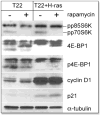Modeling resistance to pathway-targeted therapy in ovarian cancer
- PMID: 15970711
- PMCID: PMC2268865
- DOI: 10.4161/cc.4.8.1869
Modeling resistance to pathway-targeted therapy in ovarian cancer
Abstract
A detailed understanding of the biochemical pathways that are responsible for cancer initiation and maintenance is critical to designing targeted cancer therapy. Although we have accumulated knowledge about individual molecular changes that underlie cancer development, we are still learning how multiple biochemical pathways cooperate in cancer. This cooperation and cross-talk between redundant biochemical pathways appear to be the main reasons for the failure of therapeutic agents that are designed to interfere with a specific molecular target. In order to simulate the cooperation of several biochemical pathways in cancer development, we have engineered mouse ovarian cancer cell lines and tumors with different combinations of defined genetic alterations. We have used this system to determine the functional contributions of individual pathways that are necessary for cell proliferation and tumor maintenance, as well as to test the molecular mechanisms of tumor resistance to pathway-targeted therapy.
Figures


Similar articles
-
Inhibition of mammalian target of rapamycin induces phosphatidylinositol 3-kinase-dependent and Mnk-mediated eukaryotic translation initiation factor 4E phosphorylation.Mol Cell Biol. 2007 Nov;27(21):7405-13. doi: 10.1128/MCB.00760-07. Epub 2007 Aug 27. Mol Cell Biol. 2007. PMID: 17724079 Free PMC article.
-
The anti-tumor activator sMEK1 and paclitaxel additively decrease expression of HIF-1α and VEGF via mTORC1-S6K/4E-BP-dependent signaling pathways.Oncotarget. 2014 Aug 15;5(15):6540-51. doi: 10.18632/oncotarget.2119. Oncotarget. 2014. PMID: 25153728 Free PMC article.
-
Adaptation to mTOR kinase inhibitors by amplification of eIF4E to maintain cap-dependent translation.J Cell Sci. 2014 Feb 15;127(Pt 4):788-800. doi: 10.1242/jcs.137588. Epub 2013 Dec 20. J Cell Sci. 2014. PMID: 24363449
-
The molecular target of rapamycin (mTOR) as a therapeutic target against cancer.Cancer Biol Ther. 2003 Jul-Aug;2(4 Suppl 1):S169-77. Cancer Biol Ther. 2003. PMID: 14508096 Review.
-
Not all substrates are treated equally: implications for mTOR, rapamycin-resistance and cancer therapy.Cell Cycle. 2009 Feb 15;8(4):567-72. doi: 10.4161/cc.8.4.7659. Epub 2009 Feb 18. Cell Cycle. 2009. PMID: 19197153 Review.
Cited by
-
Combination of intensity modulated radiotherapy followed treatment with p38 MAPK activation inhibitor inhibits the proliferation of MCF-7 breast cancer cells.Saudi J Biol Sci. 2018 Jan;25(1):10-14. doi: 10.1016/j.sjbs.2017.01.061. Epub 2017 Feb 2. Saudi J Biol Sci. 2018. PMID: 29379349 Free PMC article.
-
Metformin Improves Ovarian Cancer Sensitivity to Paclitaxel and Platinum-Based Drugs: A Review of In Vitro Findings.Int J Mol Sci. 2022 Oct 25;23(21):12893. doi: 10.3390/ijms232112893. Int J Mol Sci. 2022. PMID: 36361682 Free PMC article. Review.
-
Molecular events in the pathogenesis of vulvar squamous cell carcinoma.Semin Diagn Pathol. 2021 Jan;38(1):50-61. doi: 10.1053/j.semdp.2020.09.010. Epub 2020 Sep 25. Semin Diagn Pathol. 2021. PMID: 33032902 Free PMC article. Review.
-
Targeting mTOR and eIF4E: a feasible scenario in ovarian cancer therapy.Cancer Drug Resist. 2021 May 11;4(3):596-606. doi: 10.20517/cdr.2021.20. eCollection 2021. Cancer Drug Resist. 2021. PMID: 35582305 Free PMC article. Review.
-
Metformin combined with p38 MAPK inhibitor improves cisplatin sensitivity in cisplatin‑resistant ovarian cancer.Mol Med Rep. 2014 Nov;10(5):2346-50. doi: 10.3892/mmr.2014.2490. Epub 2014 Aug 14. Mol Med Rep. 2014. PMID: 25118792 Free PMC article.
References
-
- Orsulic S. An RCAS-TVA-based approach to designer mouse models. Mamm Genome. 2002;13:543–7. - PubMed
-
- Guba M, von Breitenbuch P, Steinbauer M, Koehl G, Flegel S, Hornung M, Bruns CJ, Zuelke C, Farkas S, Anthuber M, Jauch KW, Geissler EK. Rapamycin inhibits primary and metastatic tumor growth by antiangiogenesis: Involvement of vascular endothelial growth factor. Nat Med. 2002;8:128–35. - PubMed
-
- Hidalgo M, Rowinsky EK. The rapamycin-sensitive signal transduction pathway as a target for cancer therapy. Oncogene. 2000;19:6680–6. - PubMed
Publication types
MeSH terms
Substances
Grants and funding
LinkOut - more resources
Full Text Sources
Medical
Miscellaneous
